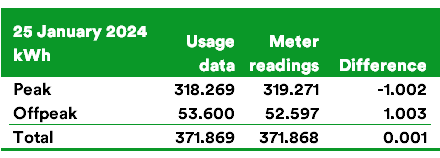It is vitally important that electricity meters record accurately; meter readings form the basis for billing, so inaccurate readings will have financial consequences for both buyer and seller - customer and supplier. Meters have to be certified by the manufacturer to achieve a certain minimum degree of accuracy, and customers can usually assume that their meters are recording their usage with an accuracy of better than ±1%.
Customers with multi-rate tariffs like Economy 7 or Economy 10 have also to be confident that the readings on which their peak/offpeak usage is based are also accurate. There has been some doubt about this, so I checked my own experience.
Many OVO customers have been partaking in the Power Move scheme, encouraging us to shift consumption out of the period of highest demand into periods of lower demand. For the more pedantic of us, this has meant keeping a close eye on the half-hourly usage data smart meters provide. Modern smart meters record the usage in each half hour to the nearest Wh (0.001kWh); older ones may only record to the nearest 5 Wh. So we should be able to add up the usage for all 48 half-hours in a day to see the figure that should be added to last night's meter reading (also to the nearest Wh) to get tonight's reading.
More than that, though, for multi-rate meters: the total of half-hourly usage in a day's offpeak period(s) should be equal to the difference between yesterday's offpeak reading and today's, and similarly for peak periods.
This was the result on one day for my Economy 7 meter, 120 days after its installation:

The meter total has remained within (to me) acceptable limits throughout the meter's active life; the 0.001 figure may well be -0.001 tomorrow. And it's remarkable that the sum of 5760 numbers is more or less identical in my computer and OVO's. However, the peak period register has consistently recorded a higher figure than the half-hourly data would suggest, while the off-peak register's reading is correspondingly lower.
It has taken 120 days for this discrepancy to reach 1.0kWh, so it is of course insignificant (1.0 kW charged at the wrong rate costs me 1.0 x 10p, being the difference between peak and offpeak rates. 10p in 120 days amounts to 30p a year). However, for big consumers, not to mention industrial ones, it could be a substantial figure, and of course it's a considerable amount of money in the bank for OVO.
How does this discrepancy arise? My guess is that it's just a question of timing. At midnight each day, the meter has to transmit both the half-hourly data to DCC for the period 23:30-23:59 and the meter readings to OVO. These two transmissions can't take place simultaneously, so there is bound to be a brief delay in one of them. It looks like it's the readings that are sent a little bit later. I haven't been able to find any correlation between the size of the discrepancy on any particular day with the power draw at the time, so I suspect it's completely random. It varies from 3Wh to 30Wh, with an average of (1.003/120=) 8.4Wh. It's interesting that - in this one-instance sample - the discrepancy is always in OVO's favour. I wonder if that's always the case.
Given this apparent fact of life - that offpeak usage will always be under-reported by a tiny amount - we have to consider how to minimize its effect. The easy way is to ensure that any equipment designed to take advantage of cheaper rates isn't activated until some time after the cheap period starts and is deactivated some time before it ends. This may well happen automatically if it's the meter that controls the timings, by virtue of the 'random offset' introduced to ensure that not all power-hungry appliances (e.g. storage heaters) switch on at precisely the same time. I don't know whether this offset is also applied at the end of the cheaper period; this may not be so important, because this type of equipment will usually not be active for the whole period, having achieved saturation some time earlier.
Bottom line:
- Half-hour usage data for a day match exactly to meter readings, at least those recorded and transmitted with three decimal digit precision. Adding one day's usage to the meter reading at its start will produce the reading at its end ± 0.001kWh.
- Readings taken from more than one register do not match exactly to their expected values arrived at by summing the half-hourly data for the periods covered by each register. In this one sample, offpeak usage is under-reported by about 2%.







